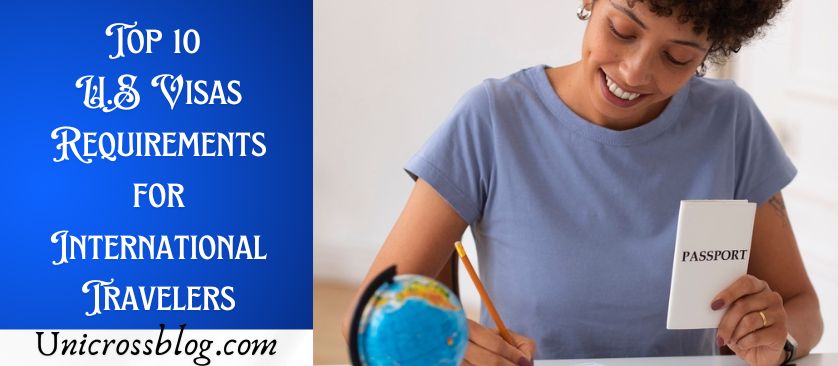As an international traveler planning a trip to the United States, navigating the complex visa requirements can be daunting. Understanding the top U.S. visa categories and their specific stipulations is crucial for a smooth entry process.
Whether you’re visiting for business, pleasure, or academic pursuits, knowing which visa suits your needs and how to obtain it is essential. This article will guide you through the top 10 U.S. visa requirements, providing valuable insights to help you prepare for your journey.
From tourist visas to work permits, you’ll discover the key information necessary to ensure your travel plans align with U.S. immigration regulations.

Top 10 U.S Visas Requirements for International Travelers
1. Valid Passport
A valid passport is essential for international travel, particularly for entering the United States. Your passport must be valid for at least six months beyond your intended stay. Make sure it is in good condition, free of any tears or damage that could raise concerns at border control.
2. Completed Visa Application Form
Filling out the DS-160 form is a crucial step in the visa application process. This online form requires detailed personal information, travel plans, and background details. Take your time to complete it accurately, as errors could lead to delays or even visa denial.
3. Passport-Style Photograph
A recent, high-quality photograph meeting U.S. specifications is required. The photo should be 2×2 inches (51×51 mm) in size, taken within the last six months, and feature a full-face view with a neutral expression against a white or off-white background.
4. Proof of Financial Stability
You’ll need to demonstrate that you can support yourself during your stay in the U.S. This typically involves bank statements, pay stubs, or other financial documents showing sufficient funds. The amount required varies depending on the length and purpose of your visit.
5. Evidence of Ties to Home Country
To alleviate concerns about overstaying your visa, you must provide proof of strong ties to your home country. This could include:
- Employment letter stating your position and expected return date
- Property ownership documents
- Family ties (marriage certificate, birth certificates of children)
- Enrollment in educational programs back home
6. Travel Itinerary
A detailed itinerary of your planned activities in the U.S. is often required. This should include:
- Flight reservations (both to and from the U.S.)
- Hotel bookings or accommodation arrangements
- Planned tourist activities or business meetings
7. Letter of Invitation (if applicable)
For business or personal visits, a letter of invitation from your U.S. host can strengthen your application. This should outline the purpose and duration of your visit, as well as any financial support they’ll provide.
8. Medical Examination Results
Certain visa categories require a medical examination from an approved physician. This ensures you meet U.S. health requirements and don’t pose a public health risk.
9. Criminal Record Check
A clean criminal record is crucial for visa approval. You may need to provide police clearance certificates from countries where you’ve lived for six months or more since age 16.
10. Visa Application Fee Receipt
Most visa applications require a non-refundable fee. Keep the receipt as proof of payment, as you’ll need to present it during your visa interview.
Additional Considerations
Remember, these requirements can vary based on the specific visa type you’re applying for. Student visas (F-1) may require additional documentation like acceptance letters and I-20 forms, while work visas (H-1B) often need employer sponsorship letters and educational credentials.
It’s crucial to start the application process well in advance of your intended travel date. Visa processing times can vary significantly, and you may need to schedule an in-person interview at a U.S. embassy or consulate.
Lastly, honesty is paramount throughout the application process. Providing false information or documents can result in permanent ineligibility for U.S. visas. When in doubt, consult the official U.S. Department of State website or seek guidance from a qualified immigration attorney to ensure you’re meeting all necessary requirements for your specific situation.
READ ALSO: Student Visa Requirements in the US: Process and Fees
FAQs
What is the processing time for U.S. visa applications?
Processing times for U.S. visas can vary significantly depending on the type of visa and current workload at the specific embassy or consulate. Generally, non-immigrant visas like tourist or business visas (B1/B2) are processed more quickly than immigrant visas. On average, you can expect processing times to range from a few weeks to several months.
It’s important to note that processing times are just estimates and can change based on various factors. To get the most up-to-date information, check the U.S. Department of State’s Visa Wait Times page, which provides current processing times for different visa categories at each U.S. embassy and consulate worldwide.
Can I expedite my visa application?
In certain circumstances, you may be eligible for expedited visa processing. The U.S. Department of State offers expedited appointments for emergencies such as the death of an immediate family member, urgent medical treatment, or unforeseen business-related travel.
To request an expedited appointment, you’ll need to provide documentation supporting your case. Keep in mind that expedited processing is granted on a case-by-case basis and is not guaranteed. Even if approved, you’ll still need to meet all regular visa requirements and pay standard fees.
What should I do if my visa application is denied?
If your visa application is denied, don’t lose hope. The consular officer will provide you with a written explanation for the denial, citing the specific section of U.S. immigration law that applies to your case. Review this information carefully to understand the reason for the denial.
In many cases, you can reapply for a visa, especially if you can provide additional information or documentation that addresses the concerns raised in your initial application. However, it’s crucial to carefully consider the reason for denial and ensure you’ve addressed it before reapplying. In some cases, you may need to wait for a specified period before submitting a new application.
If you believe the denial was made in error or you have new information that significantly changes your eligibility, you can request a review of your case. This process varies depending on the visa category and the specific U.S. embassy or consulate.
Are there any special considerations for students applying for U.S. visas?
Students applying for F-1 or M-1 visas should be aware of some unique requirements. In addition to standard visa documentation, you’ll need to provide:
- Form I-20: This is issued by your U.S. school or university after you’ve been accepted.
- Proof of financial support: You must demonstrate that you have sufficient funds to cover your tuition and living expenses for the duration of your studies.
- Evidence of strong ties to your home country: This could include family connections, property ownership, or job prospects upon return.
Student visa applicants should also be prepared to discuss their academic plans, including their chosen field of study and how it relates to their career goals. Demonstrating a clear intention to return to your home country after completing your studies is crucial for a successful application.
How long can I stay in the U.S. with a tourist visa?
A B1/B2 tourist visa typically allows for stays of up to six months per visit. However, it’s important to understand that the visa itself doesn’t determine your length of stay. When you enter the U.S., a Customs and Border Protection (CBP) officer will decide how long you can remain in the country, which may be less than six months.
The duration of your authorized stay will be noted on your I-94 form, which you can access online. It’s crucial to adhere to this date and not overstay your welcome, as doing so can result in serious consequences, including being barred from re-entering the U.S. in the future.
Remember, a tourist visa is for temporary visits and does not allow you to work or study in the U.S. If your plans change and you need to stay longer, you must apply for an extension before your authorized stay expires.







